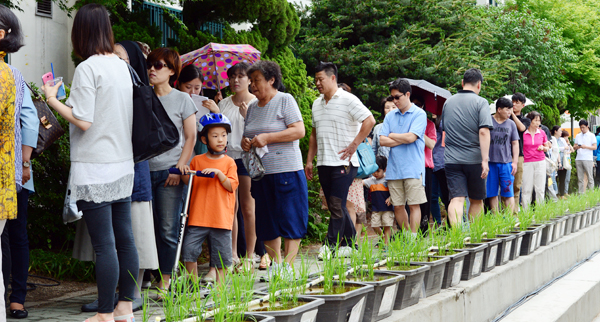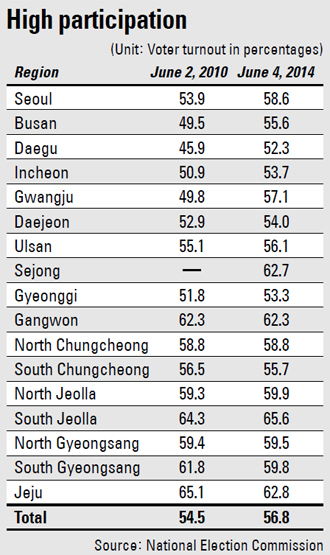Local elections record largest turnout in 16 years

Voters wait in line to cast their ballots for local elections yesterday at a polling station set up in Jaedong Elementary School in Jongno District, central Seoul. [NEWS1]
But that still fell short of predictions made by the top election watchdog, which said the total turnout could exceed 60 percent following the highest-ever advance voting turnout and the unpredictable outcome of the elections themselves.
The advance voting turnout on Friday and Saturday yielded a record 11.5 percent, or more than 4.74 million people, with unexpectedly active participation from young voters in their 20s.
The turnout yesterday was 2.3 percent higher than for the last local elections, held in 2010, in which 54.5 percent of eligible voters cast ballots.
In comparison, the first local elections in 1995 had a record turnout of 68.4 percent, and subsequent local elections had never surpassed the 60 percent mark.
There were more than 41.29 million eligible voters — those aged 19 and over — for the elections, or more than 80 percent of the nation’s population of 51.33 million, according to the National Election Commission.
A record 48,400 foreigners were among those eligible to vote.
In 2006, foreigners aged 19 years and older who had permanent residency status and had lived for more than three years in Korea were granted the right to vote in local elections.
Many female immigrants from multi-ethnic families have been actively campaigning to mobilize eligible foreigners to vote ahead of the local elections.
The polls were open for 12 hours, between 6 a.m. and 6 p.m., and voting was conducted at 13,665 stations in 17 cities and provinces nationwide, with 236,566 staff administering voting.
Some 58.6 percent of Seoul’s 8.44 million eligible voters turned up to cast ballots yesterday — higher than the national average, according to the National Election Commission.

In contrast, major cities had less stellar turnout rates. Ruling party stronghold Daegu counted the lowest rate of voting at 52.3 percent, followed by Gyeonggi at 53.3 percent and Incheon at 53.7 percent.
Ansan, the Gyeonggi city under a pall since hundreds of students from its Danwon High School were lost in the Sewol ferry disaster on April 16, counted a voter turnout of 48.1 percent, lower than the provincial average.
Gyeonggi, the most populous province, has 9.68 million eligible voters but traditionally sees a low turnout.
In comparison, in the June 2, 2010, local elections, the highest turnout was in Jeju at 65.1 percent, trailed by South Jeolla at 64.3 percent and Gangwon at 62.3 percent.
Similarly, cities had a lower percentage of voters that year. Seoul’s turnout was 53.9 percent, Incheon had the lowest rate at 50.9 percent and Gyeonggi was slightly higher at 51.8 percent, according to the National Election Committee.
For the May 31, 2006, local elections, the turnout was even lower at 51.6 percent. The percentage of voters in Seoul was below the national average at 49.8 percent.
Jeju, on the other hand, saw a whopping 67.3 percent turnout, ahead of North Jeolla’s 64.3 percent. Incheon logged the lowest at 44.3 percent.
In 1998, voters numbered 52.7 percent, dipping further to 48.9 percent in 2002.
In contrast, the turnout for the 2012 presidential election in December was 75.8 percent, where votes from the older generations in their 50s and 60s made a decisive difference.
About 1.16 million out of more than 7.3 million eligible voters between the ages of 19 and 29 cast ballots in the two-day early voting held over
the weekend, making up 15.97 percent of the total votes. The main advance voting participants were people serving military duty.
Analysts pointed to various reasons why voting rates were not as high as initially anticipated, including because of the long weekend followed by a national holiday for the elections yesterday and Memorial Day tomorrow.
BY SARAH KIM [sarahkim@joongang.co.kr]










with the Korea JoongAng Daily
To write comments, please log in to one of the accounts.
Standards Board Policy (0/250자)